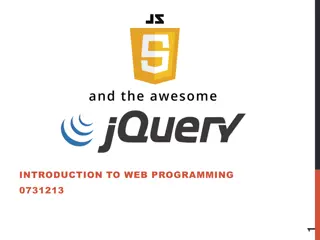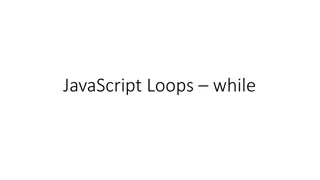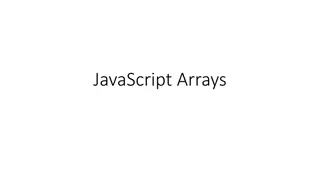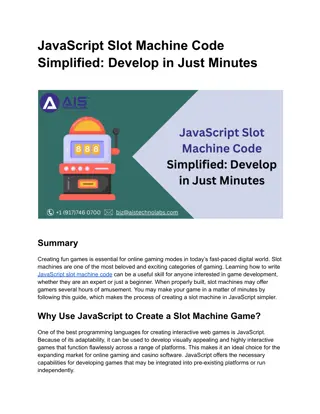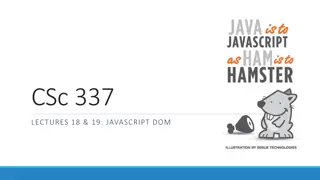Front End Javascript
JavaScript is an interpreted language with just-in-time compilation and garbage collection. It is multi-paradigm, with some object-oriented features, no inheritance or encapsulation, and syntactical similarities to languages like Java, C, Python, and C#. JavaScript supports functional programming and prototype-based programming, allowing dynamic addition of properties and methods. It emphasizes first-class functions and flexibility in object creation without strict class definitions.
Download Presentation

Please find below an Image/Link to download the presentation.
The content on the website is provided AS IS for your information and personal use only. It may not be sold, licensed, or shared on other websites without obtaining consent from the author.If you encounter any issues during the download, it is possible that the publisher has removed the file from their server.
You are allowed to download the files provided on this website for personal or commercial use, subject to the condition that they are used lawfully. All files are the property of their respective owners.
The content on the website is provided AS IS for your information and personal use only. It may not be sold, licensed, or shared on other websites without obtaining consent from the author.
E N D
Presentation Transcript
Front End Javascript SWEN-344 Web Engineering
JavaScript (JS) function sayHello() { return "Hello, "; } Interpreted language, Just-in-time compiled Garbage collected Multi-paradigm Has some OO, but no inheritance or encapsulation Has lots of C-style procedural syntax Functional programming influence Prototype-based programming Add properties and methods at runtime to another object, e.g. empty object You can create an object without first creating a class First-class functions A function can be treated like any other variable E.g. sayHello() No concept of input or output - just modifying the host environment function greeting(helloCallback, name){ console.log(helloCallback() + name); } greeting(sayHello, "world!");
Similarities to Java, C, Python, C#, etc. For-loops: for(let i=0; i<5;i++){} For-in-loops:, for(foo in bars){} NaN, Infinity, -Infinity, isFinite() while(true){} do {} while(true); if(condition){} else {} if(condition){} else if {} else {} switch(expression){case 1: stmt; break; default: } break and continue Regex literals /a+b*/ True/ False/ Undef. : false, undefined, null, 0, NaN, = is assignment, == and === are comparison (see next slide)
Equals 1 '1' 1 0 0 var object1 = {'key': 'value'}, object2 = {'key': 'value'}; object1 == object2 // false 0 == undefined null == undefined 1 != 2 // true 1 != '1' // false 1 != "1" // false 1 != true // false 0 != false // false == 1 == 1 == '1' == false == null // true // true (type conv) // true // true // false //strict equality, no type conversion 3 === 3 // true 3 === '3' // false var object1 = {'key': 'value'}, object2 = {'key': 'value'}; object1 === object2 //false // false // true 3 !== '3' // true 4 !== 3 // true
Declaring a Variable if(true) { let foo = 'a'; const bar ='b'; var baz = 'c'; } console.log(foo); // NOT available here let - declare block-level variables const - same as let, but will never change var - available outside the block, within this function console.log(bar); // NOT available here Style tip: use let and const as often as you can Maintainability: keep your code modular Performance: tell the interpreter you re done with it console.log(baz); // IS available
Strings and template literals String interpolation is replacing placeholders with values in a string literal. The string interpolation in JavaScript is performed by template literals (strings wrapped in backticks `) and ${expression} as a placeholder. For example: No distinction between single- and double- quoted strings Template literals Great for multi-line strings with readable interpolation Avoid plus-and-quote readability in your code Interpolation available const number = 42; const message = `The number is ${number}`; message; // => 'The number is 42' let a = 'a' let b = "b" const foo = function() { return 'interpolation' } let c = `This is a long, string with a second line and some ${foo()}`
Functions function sayHi() { console.log('hi') } const sayHello = function() { console.log('hello') } sayHi(); sayHello(); // hi hello Functions can be anonymous or named Closures: functions within other functions Captures the surrounding context Cannot be accessed outside the parent function Used to fake OO encapsulation Can be slow and memory-intensive! Every object gets its own copy of a function this: refers to the current function (as an object!?!?) Arrow functions Shorthand for function() {} Does not redefine this, arguments, super, new.target Avoids the need for the self = this; self.foo() hack PRO: cleaner, simpler CON: can t do fancy metaprogramming Intent: use them for quick little callbacks (look- ahead: fetch/ promise) // common mistake: forgetting the () sayHi; // does nothing! arrowFunc = (x) => { console.log(x) } arrowFunc('yo'); // yo
function Person(first, last) { this.first = first; this.last = last; this.fullName = function() { // nested! return this.first + ' ' + this.last; }; } new Person('Duane','Allman').fullName(); Classes are just functions The new keyword will: Create an empty Object Then run Person() with that object set to this But! What if we create 1000x Persons?? That s 1000 copies of fullName()! Use the prototype instead to keep the memory allocation lower Private methods? Instead of nesting, use convention Underscore methods are considered to be private or internal E.g. _myPrivateMethod() // only one copy of fullName with prototype function Person(first, last) { this.first = first; this.last = last; } Person.prototype.fullName = function() { return this.first + ' ' + this.last; }; new Person('Greg', 'Allman').fullName();
Closure Examples // BEWARE of Closures+for-loops function showHelp(help) { document.getElementById('help').innerHTML = help; } function setupHelp() { var helpText = [ {'id': 'email', 'help': 'Your e-mail address'}, {'id': 'name', 'help': 'Your full name'}, {'id': 'age', 'help': 'Your age'}]; // Closures capture the environment var e = 10; function sum(a){ return function(b){ return function(c){ // outer functions scope return function(d){ // local scope return a + b + c + d + e; }}}} for (var i = 0; i < helpText.length; i++) { var item = helpText[i]; document.getElementById(item.id).onfocus = function() { showHelp(item.help); } }} console.log(sum(1)(2)(3)(4)); // 20 setupHelp(); // Alternatives: for..in, forEach, let
Object or {} let a = { 'key': 'value' }; console.log(a) // { 'key': 'value' } console.log(a.key); // 'value' console.log(a['key']); // 'value' JavaScript Object Notation (JSON) It s executable JavaScript! Security note: don t execute data. plz. Every object is basically a key-value store Values can be anything console.log(Object.keys(a)); // [ key ] console.log(Object.values(a)); // [ value ] b = new Object(); b.foo = "bar"; console.log(b); // { foo : "bar"} b.sayHi = () => console.log('hi'); b.sayHi(); // hi
Lost of other syntactic sugar Spread operator const arr1 = [1, 2, 3]; const arr2 = [4, 5, 6]; const combined = [...arr1, ...arr2]; console.log(combined); // [1, 2, 3, 4, 5, 6] const user = { id: 10001, name: 'Sam', email: 'sam74@gmail.com' }; Restructure Deconstructors const arr = [1, 2, 3, 4, 5]; const [first, second] = arr; function printName({name}) { console.log(name); } const [first, second, ...remaining] = arr;
JS + DOM manipulation const fooElem = document.getElementById("foo") fooElem.style.borderWidth = width + "px"; Global variable entrypoints document window Get a DOM element document.getElementById() document.querySelector() Others Set data in DOM element Style has many of the visual elements, e.g. color, font, padding, margin textContent - between the tags Note: innerHTML tends to be an unsafe operation - user data should never become Javascript! Append the DOM element appendChild() remove() const link = document.querySelector('a'); link.textContent = 'Go here'; link.href = 'https://example.org'; const pElem = document.createElement('p'); fooElem.appendChild(pElem); fooElem.remove()
jQuery $('div.bands') .on('click', handleTestClick) .addClass('band-clicked'); Originally created by John Resig, RIT class of 05, CS Major Was the standard for web development for a long time - largely replaced by React.js, Angular.js, Vue.js, Ember.js Still ubiquitous today. Heavily influenced JS standards today e.g. Fetch API from jQuery s $.ajax Huge ecosystem of plugins In a nutshell: $() $(selector).action() In a larger nutshell: DOM read-write in a compact, concise, readable way Method chaining CSS selection JS looks like HTML, making it easier to read and maintain $('select#bands') .append($('<option>') .attr({ value: 'U2' }) .text('U2'));
Organizing js and html Or a separate file (myjavascript.js) <head> ... <script> let d = new Date(); alert("Today's date is " + d); </script> </head> function theDate() { let d = new Date(); alert("Today's date is " + d); } OR <body> <script> let d = new Date(); document.body.innerHTML = "<h1>Today's date is " + d + "</h1>" </script> </body> <head> <script type= text/javascript src= scripts/myjavascript.js ></script> ... </head> Or in Body With large js files, loading at the END is sometimes recommended for performance
Initialization You can use javascript to initialize or set up dynamic behaviour when the page loads function initFunction() { alert( Hello, Sailor! ); } <body onload= initFunction()"> Or Or perhaps, check cookies <script type="text/javascript"> window.onload=initFunction(); </script>
JS + DOM: Events Or dynamically add listeners Specify in original HTML, or set dynamically event object passed to every handler TONS of JS events: https://developer.mozilla.org/en-US/docs/Web/Events button = document.getElementById("start") button.onclick = function() { handleClick(); } button.onclick = handleClick OR button.addEventListener('click , handleClick}; <button id="start" onClick="handleClick()"> function handleClick(event) { console.log(event) } HTML DOM Document addEventListener() Method (w3schools.com)
JS Debugging Use the browsers debugger (best option) Use browsers tools to locate your source file; visually set breakpoints in source files Step over, in, out (just like an IDE) Inspect variables; view DOM; modify DOM Inpect layout, styles View output of the browser console (output of your console.log statements At any time, you can add the debugger; line and that will fire up the browser s debugger and break at that line


